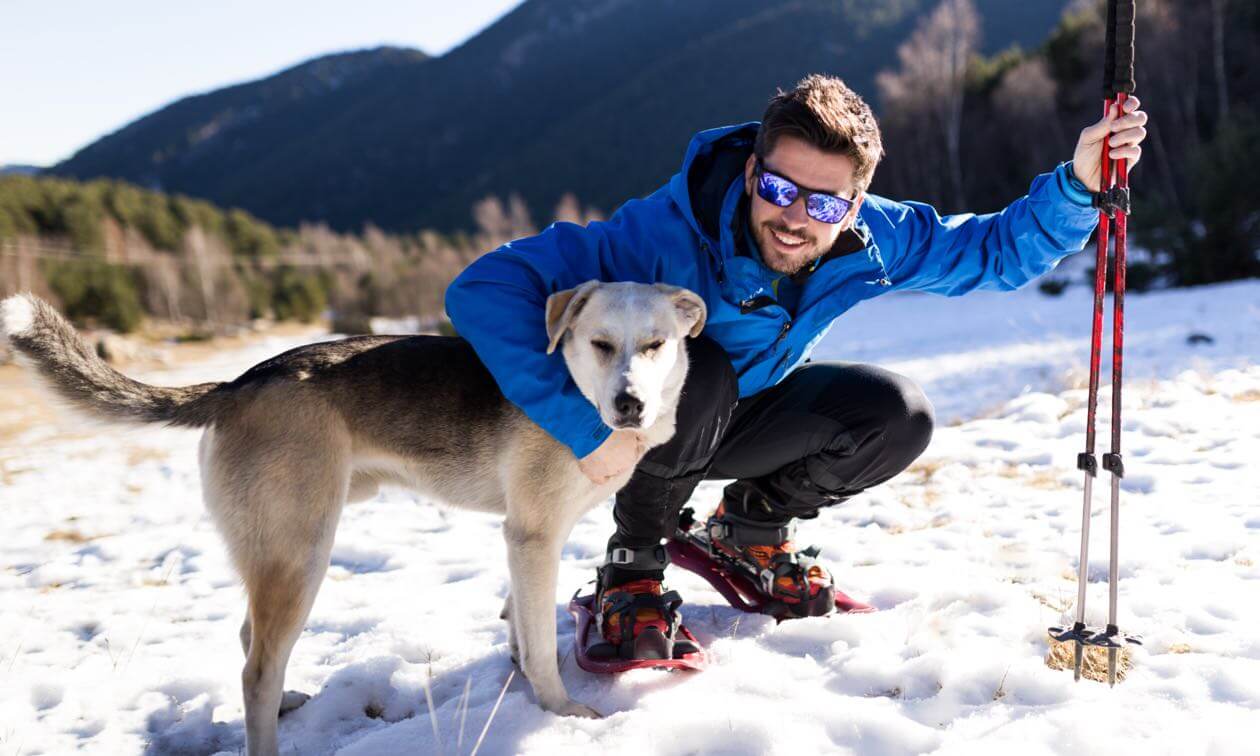Snowshoeing through a winter wonderland with your dog is a wonderful way to get outdoors and increase exercise during the colder months. The crisp winter air and snow-covered trails provide a perfect enrichment activity for your dog to explore new sights and smells. Almost any dog can go snowshoeing with you, as it's low-impact and requires less training than other winter sports.
What You'll Need for Snowshoeing with Your Dog
- Your Gear. You'll want to bring basic hiking supplies and wear warm and waterproof clothing. Make sure your hiking boots are waterproof and comfortable when strapped into your snowshoes.
- Dog Jacket. Some dog breeds are built for the snow, such as Siberian Huskies, with thick double coats. While those dogs may not need a jacket, it can be a good idea to bring one along just in case they start to get chilly. It can also help to put a jacket on them if it starts snowing. And for dogs without that thick coat, you'll want to have them wear a jacket from the start. Make sure it's waterproof and consider a warm fleece layer underneath to help keep their core temperature up.
- Dog Boots. Your dog's paws are at the most risk for frostbite when trekking through the snow. Invest in dog boots that provide traction and warmth and won't easily slip off on the trail. Another option for paw protection is paw balm or paw wax, which can help prevent ice and snow buildup between paw pads.
- Leash Belt and Leash. Attaching your dog to you using a belt and leash setup is ideal, especially if you'll be using poles while snowshoeing. A longer leash is best, approximately eight feet, so your dog can walk a bit further out from you, preventing them from tripping you up as they avoid your snowshoes and poles.
- Dog First Aid Kit. For first-aid on the go, it's helpful to have small scissors, tweezers, saline wound flush, antibiotic ointment or spray, 3 x 3 gauze pads, a roll of gauze, vet-wrap, waterproof tape, Quikstop (helps stop bleeding from a torn nail or mild abrasion), eye wash, an emergency warming sheet, and a pair of toddler socks (to cover a foot injury).
- Dog Food and Water. Bring snacks for your dog so they can refuel if needed. Water is crucial to stay hydrated, so be sure to pack enough for you and your dog, along with a portable bowl for them to drink from.
- Poop Bags. Keep the trails clean by picking up after your pooch and packing it out to throw away in an appropriate receptacle when you return to the trailhead.
Where to Go Snowshoeing with Your Dog
Before hitting the trails to snowshoe with your dog, ensure that dogs are allowed. For example, dogs are often not allowed in national parks. Check the rules for your intended trails. Groomed trails often prohibit dogs because their paws punch holes in the trail. Some hiking trails you may frequent during the summer are not good options for snowshoeing because of the avalanche risk during winter.
Safety Tips for Snowshoeing with Your Dog
- Check With Your Vet. Ensure that your dog is up to the challenge and physically ready for this new adventure. Have your veterinarian check them for any issues that hiking through the snow may worsen. Wading through deep snow is much harder than a regular hike for your dog — it requires a lot of stamina — so it's important to know their physical limitations. For your first outing with your dog, it's best to start with a short snowshoeing trip so they can get used to hiking in the snow (and you can get comfortable walking in snowshoes). Like if you were starting a new jogging regimen, you may need to slowly work them up and get your dog conditioned.
- Know Your Dog. Many snowshoeing trails are shared with cross-country skiers and other winter sports enthusiasts. If your dog is frightened or reactive towards others, it's best to leave them at home or find a quieter location.
- Keep Your Dog Hydrated. Even though you're not hiking through the summer heat, your dog is still working hard. Drinking enough water while snowshoeing is important to prevent dehydration. Stop every 20 to 30 minutes to give yourself and your dog a water break. If you have a senior dog, take water breaks more often.
- Keep Your Dog Leashed. It's especially important to always keep your dog on a leash when snowshoeing. In most locations, this is the law, and it's also polite trail etiquette. This is a safety issue when snowshoeing on shared trails with skiers moving quickly past you and your dog. It also prevents your dog from running off-trail after wildlife.
ZPC-02512





